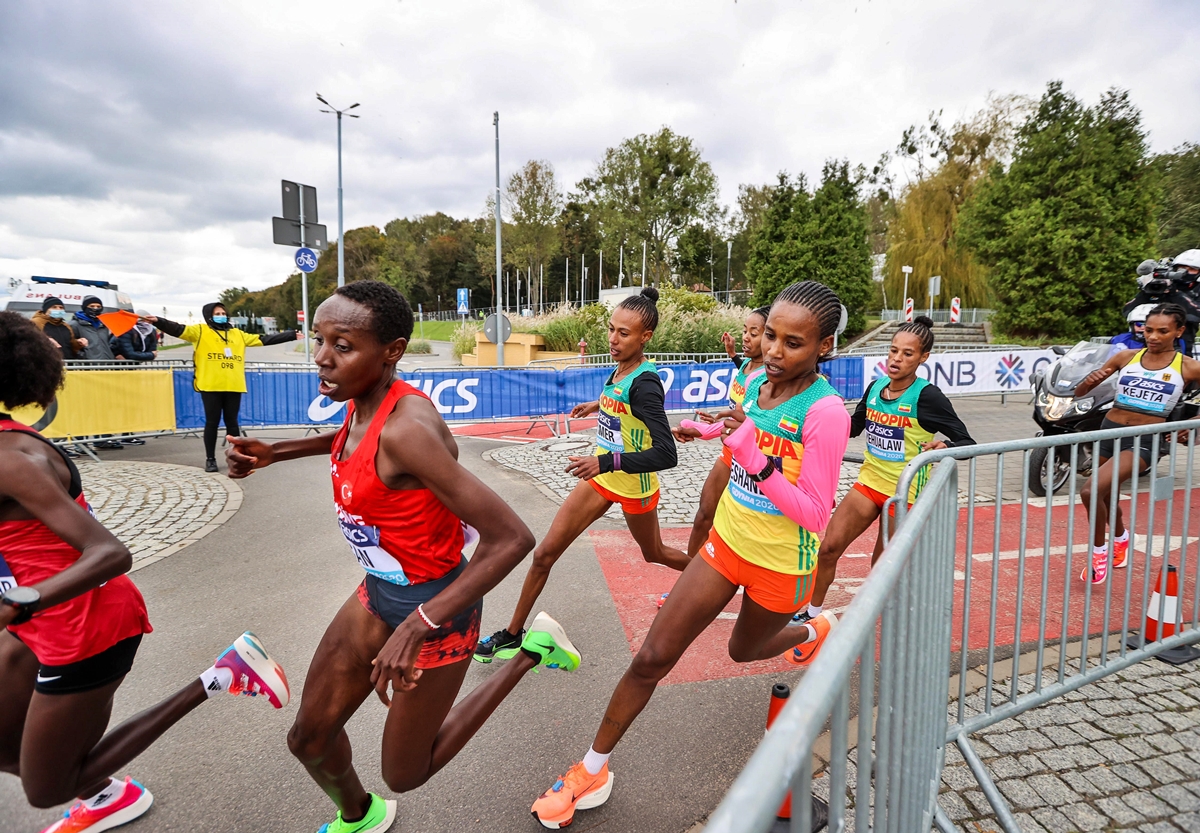Home>Misc>Featured>How Many Miles Should I Run Before A Half Marathon


Featured
How Many Miles Should I Run Before A Half Marathon
Modified: January 22, 2024
Get expert advice on how many miles you should run before a half marathon. Discover the best training tips and strategies from featured runners.
Introduction
So you’ve decided to take on the challenge of running a half marathon. Congratulations! A half marathon is a fantastic distance to test your endurance and push your limits. But before you lace up your running shoes and hit the pavement, it’s important to understand the importance of proper training and how many miles you should run before a half marathon.
Preparing for a half marathon requires time, dedication, and a strategic training plan. It’s not just about running a certain number of miles each week, but about building your endurance, improving your speed, and preventing injuries. In this article, we will explore the factors to consider when determining how many miles you should run before a half marathon, and provide tips on how to structure your training plan.
Whether you’re a seasoned runner or a beginner, it’s crucial to approach half marathon training with a balanced and gradual approach. Trying to do too much too soon can lead to burnout or injury, while not doing enough can hinder your performance on race day. By understanding the principles of proper training, you can maximize your potential and enjoy a successful half marathon experience.
Understanding Half Marathons
Before we dive into the specifics of training for a half marathon, let’s first establish what a half marathon is. A half marathon is a race that covers a distance of 13.1 miles or 21.1 kilometers. It falls in between a 10K race and a full marathon in terms of distance, making it a popular choice for runners looking to challenge themselves without committing to the grueling nature of a full marathon.
Half marathons are known for their energetic atmosphere, community spirit, and sense of accomplishment upon crossing the finish line. They attract a wide range of participants, from seasoned runners aiming for personal bests to beginners who want to test their endurance and take on a new fitness goal.
It’s important to understand that completing a half marathon requires a combination of physical fitness, mental strength, and a well-structured training plan. The distance can be challenging, but with the right preparation and mindset, it’s an achievable goal for anyone.
Half marathons also provide an opportunity for runners to set goals and track their progress. Many races offer timing systems, allowing participants to compare their performance with others and push themselves to new heights. Whether it’s completing the race in a certain time or simply crossing the finish line, the sense of accomplishment in completing a half marathon is unparalleled.
Additionally, participating in a half marathon can have several benefits for your physical and mental well-being. Running regularly can improve cardiovascular health, increase stamina, help manage weight, and boost overall fitness levels. It can also reduce stress, promote better sleep, and enhance mental clarity.
Now that we have a better understanding of what a half marathon entails, let’s explore how to prepare for this exciting challenge.
Importance of Proper Training
When it comes to running a half marathon, proper training is key to your success. It lays the foundation for improving your endurance, increasing your speed, and reducing the risk of injuries. Without a structured training plan, you may struggle to complete the race or not achieve your desired performance.
One of the main reasons why proper training is important is to gradually build your mileage and prepare your body for the demands of a half marathon. Running 13.1 miles is no easy feat, especially if you’re not accustomed to long-distance running. Through consistent training, you will gradually increase your mileage, allowing your body to adapt and get stronger over time.
Proper training also helps you develop efficient running mechanics and form, which can improve your overall performance and help prevent injuries. By incorporating strength training, cross-training, and stretching exercises into your routine, you can strengthen supporting muscles, improve flexibility, and reduce the risk of overuse injuries.
Another crucial aspect of proper training is establishing a balance between running and rest. It’s important to give your body adequate time to recover and repair itself after intense workouts. Overtraining can lead to fatigue, decreased performance, and potential injuries. By incorporating rest days into your training plan, you allow your body to recover, adapt, and become stronger.
Additionally, proper training allows you to create a routine and build the mental resilience necessary to complete a half marathon. Running long distances requires mental strength and discipline. Through consistent training, you can develop the necessary mental toughness to push through fatigue and overcome any challenges you may encounter on race day.
In summary, proper training is essential for preparing your body, improving your performance, and reducing the risk of injuries. By following a well-structured training plan and incorporating rest and recovery, you will be better equipped to tackle the half marathon distance and achieve your goals.
Factors to Consider
When determining how many miles you should run before a half marathon, there are several factors to take into consideration. These factors will help you tailor your training plan to your individual needs and abilities. Let’s explore them in more detail:
- Current fitness level: Assessing your current fitness level is crucial in determining how many miles you should run before a half marathon. If you are a beginner or have been away from running for a while, it’s important to start with a lower mileage and gradually increase it over time.
- Past running experience: Your past running experience plays a role in determining your starting point. If you have previous experience with long-distance running or have completed races before, you may be able to handle higher mileage from the start.
- Time available for training: Consider the amount of time you have available to dedicate to training. If you have a busy schedule, you may need to adjust your training plan to fit in shorter, more frequent runs rather than long, time-consuming ones.
- Injury history: If you have a history of running-related injuries, it’s important to be cautious and gradually increase your mileage to reduce the risk of re-injury. Consulting with a healthcare professional or a running coach can help you determine the appropriate mileage for your situation.
- Overall health and fitness: Take into account your overall health and fitness level when planning your training. If you have any pre-existing health conditions or concerns, it’s important to consider them and consult with a healthcare professional before embarking on a half marathon training program.
- Race goals: Consider your goals for the race. Are you aiming to simply complete the half marathon, or do you have a specific time goal in mind? Your goals may influence the intensity and volume of your training.
- Support network: Assess the support network around you. Do you have access to a running group, training partners, or a coach? Having a support system can provide guidance, motivation, and accountability throughout your training.
By taking these factors into consideration, you can develop a training plan that is tailored to your individual needs and goals. Remember that everyone is different, and what works for one person may not work for another. It’s essential to listen to your body, make adjustments as needed, and find a balance that works for you.
Establishing a Base Mileage
Before you begin training for a half marathon, it’s important to establish a base mileage. The base mileage refers to the weekly distance you are comfortable running before starting a structured training plan. This step is crucial for building a foundation of endurance and preparing your body for the demands of half marathon training.
The recommended base mileage can vary depending on factors such as your fitness level and running experience. As a general rule, it’s advisable to have a base mileage of at least 10-15 miles per week before starting half marathon training. However, if you are a beginner or have been away from running for a while, you may start with a lower base mileage and gradually increase it over time.
When establishing your base mileage, it’s important to prioritize consistency over distance. Focus on running regularly, even if it means starting with shorter runs. This will help you build a strong foundation and reduce the risk of overuse injuries.
During the base mileage phase, pay attention to how your body feels and gradually increase your mileage over the course of several weeks. It’s advisable to increase your weekly mileage by no more than 10% each week to avoid overtraining. This gradual approach allows your body to adapt and get stronger without putting too much stress on your muscles and joints.
In addition to running, incorporate cross-training activities such as cycling, swimming, or strength training into your routine. This helps to improve overall fitness and prevent muscle imbalances.
Remember, the base mileage phase is the starting point of your half marathon training journey. It sets the stage for the more intense training that lies ahead. By establishing a solid base mileage, you will be better equipped to handle the gradual increase in mileage and intensity as you progress through your training plan.
Once you have established a comfortable base mileage, you’re ready to move on to the next phase of half marathon training – building endurance.
Building Endurance
Building endurance is a crucial component of training for a half marathon. Endurance refers to your ability to sustain a steady pace over a prolonged period of time. By focusing on building endurance, you will develop the stamina needed to complete the 13.1-mile distance.
To build endurance, it’s important to gradually increase your weekly mileage. Start by adding one or two longer runs to your training schedule each week. These runs should be done at a comfortable, conversational pace, allowing your body to adapt to the increased distance.
An effective approach to building endurance is to incorporate a long run into your training plan. The long run should be done once a week and gradually increase in distance over time. Start with a distance that is challenging but manageable, and then add 1-2 miles to your long run each week. This gradual progression allows your body to adapt and improve its endurance capabilities.
In addition to longer runs, incorporating tempo runs and speed work into your training can also help build endurance. Tempo runs involve running at a comfortably hard pace for a sustained period of time, typically around 80-85% of your maximum effort. These runs improve your lactate threshold, allowing you to sustain a faster pace for longer periods of time.
Speed work, such as interval training and hill repeats, also plays a role in building endurance. These workouts involve short bursts of high-intensity running followed by periods of rest or recovery. By pushing your body to its limits during these workouts, you will improve your cardiovascular fitness, speed, and overall endurance.
Remember, building endurance takes time, patience, and consistency. It’s important to listen to your body, take rest days when needed, and avoid the temptation to increase mileage too quickly. Gradual progress is key to avoiding overuse injuries and maintaining long-term sustainability in your training.
Building endurance is an ongoing process throughout your half marathon training. The endurance you develop will carry you through the race, allowing you to maintain a steady pace and conquer the distance. With a solid foundation of endurance, you’ll be ready to take on the next phase – incorporating speed and tempo runs.
Speed and Tempo Runs
Incorporating speed and tempo runs into your half marathon training plan can help improve your overall performance and increase your race pace. These workouts focus on running at faster speeds, challenging your body to sustain a quicker pace over shorter distances.
Speed workouts, also known as interval training, involve running short bursts of high-intensity effort followed by periods of rest or recovery. These workouts help improve your cardiovascular fitness, increase your running economy, and enhance your ability to maintain a faster pace during the race.
One popular speed workout is the “400-meter repeats,” where you run at a fast pace for 400 meters, followed by a recovery jog or walk. Repeat this cycle several times, gradually increasing the number of repeats as your fitness improves. Another option is the “800-meter repeats,” which follows the same concept but with longer intervals.
Tempo runs, on the other hand, focus on running at a comfortably hard pace for a sustained period of time. This pace should be challenging, but not so intense that you cannot maintain it for the entire duration of the run. Tempo runs help improve your lactate threshold, which is the point at which lactic acid builds up in your muscles.
To incorporate tempo runs into your training, start with a warm-up jog, then pick up the pace to your targeted tempo pace and sustain it for a continuous period, usually between 20-30 minutes. Finish off with a cool-down jog. As your fitness improves, you can gradually increase the duration or intensity of your tempo runs.
These speed and tempo runs should be incorporated into your training schedule once or twice a week. However, it’s important to note that they are intense workouts that require proper warm-up and cool-down, as well as adequate rest and recovery. Be sure to listen to your body and adjust the pace and distance as needed.
Speed and tempo runs not only help improve your race pace and overall performance but also provide variety and excitement to your training routine. They challenge your body in different ways and prevent boredom from setting in during the long weeks of half marathon training.
Remember, speed and tempo runs are supplementary to your long runs and base mileage. They should be balanced with adequate rest days to prevent overtraining and reduce the risk of injuries. By incorporating these workouts into your training plan, you’ll be on your way to running your fastest half marathon yet.
Incorporating Interval Training
Interval training is a powerful tool that can take your half marathon training to the next level. By incorporating interval workouts into your training plan, you can improve your speed, endurance, and overall race performance.
Interval training involves alternating periods of high-intensity effort with periods of rest or active recovery. These workouts challenge your cardiovascular system, increase your anaerobic threshold, and train your body to sustain faster paces.
One popular interval workout for half marathon training is the “2-minute on, 1-minute off” workout. Start with a warm-up jog, then run at a faster pace for 2 minutes, followed by a 1-minute recovery jog or walk. Repeat this cycle several times, gradually increasing the number of intervals as your fitness improves.
Another option is the “pyramid” workout, where you start with short, fast intervals (such as 200 meters), gradually increase the distance with each interval, and then work back down. For example, you could start with 200 meters, then run 400 meters, 800 meters, 1,000 meters, and then work your way back down to 400 meters and 200 meters. This workout challenges your body to maintain different paces and distances.
When incorporating interval training into your training plan, it’s important to listen to your body and adjust the intensity and duration as needed. Remember to start with shorter intervals and gradually increase the duration and intensity over time. It’s normal to feel fatigued after intense interval workouts, so be sure to allow for adequate rest and recovery days in between these sessions.
Interval training not only improves your speed and endurance but also helps break up the monotony of long-distance running. These high-intensity workouts add variety and excitement to your training routine and keep you motivated throughout your half marathon journey.
Remember, interval training is an intensive form of exercise and should be incorporated into your training plan alongside your base mileage, long runs, and other types of workouts. It’s essential to maintain a balanced training program that includes rest, recovery, and cross-training activities to prevent overuse injuries and ensure optimal performance.
By incorporating interval training into your half marathon training plan, you can push your boundaries, improve your race pace, and boost your overall performance on race day.
Long Runs and Increasing Mileage
Long runs are a fundamental component of half marathon training. These runs help build your endurance, increase your aerobic capacity, and prepare you for the distance of the race. As you progress in your training, it’s important to gradually increase your long run distance to match the demands of the half marathon.
When starting your half marathon training, your long runs will typically be shorter in distance compared to the actual race distance. As a general guideline, aim to increase your long run distance by about 1-2 miles (or 10-20 minutes) each week during the course of your training.
The long run pace should be comfortable and conversational, allowing you to sustain the distance without feeling overly fatigued. It’s important to remember that the purpose of the long run is to build endurance, not to race at a fast pace. Save your speed and tempo workouts for other training sessions.
During your long runs, it’s a good idea to practice your race day nutrition and hydration strategy. Experiment with different energy gels, snacks, and hydration options to find what works best for you. It’s also advisable to wear the same shoes and clothing that you plan to wear on race day to ensure comfort and reduce the risk of chafing or blisters.
In addition to increasing your long run distance, it’s important to include regular rest and recovery days. These rest days allow your body to repair and rebuild, reducing the risk of injuries. It’s recommended to have at least one or two rest days each week, depending on your fitness level and training intensity.
As you approach the final weeks of your training, consider incorporating a few “dress rehearsal” long runs. These runs should closely mimic the conditions of race day, including the distance, pacing, nutrition, and hydration. This will help build your confidence and familiarize yourself with what to expect on race day.
Gradually increasing your long run distance and incorporating proper rest and recovery is key to safely and effectively preparing for a half marathon. Remember to listen to your body, be flexible with your training plan, and make adjustments as needed. Every runner is unique, so find what works best for you and your individual needs.
By consistently increasing your long run distance and finding the right balance between training and recovery, you’ll be better equipped to tackle the half marathon distance and achieve your race day goals.
Tapering and Rest Days
As you approach the final weeks of your half marathon training, it’s important to incorporate tapering and rest days into your plan. Tapering refers to reducing your training volume and intensity in the weeks leading up to the race. This period of rest and recovery is crucial for allowing your body to repair, replenish, and be in peak condition for race day.
Tapering typically begins about two to three weeks before the race. During this time, you gradually decrease your mileage and intensity, allowing your muscles to recover while maintaining your fitness levels. The exact length and extent of tapering will vary depending on your training schedule, fitness level, and personal preference.
The purpose of tapering is to reduce accumulated fatigue, repair any muscle damage, and ensure your body is well-rested for race day. It allows you to fully recover from the rigors of training and ensures that you’re in the best possible shape to perform at your peak on race day.
During the taper period, focus on shorter, easier runs to maintain your fitness without overexerting yourself. It’s important to resist the temptation to squeeze in extra mileage or intense workouts during this time. Instead, trust in the training you have done and allow your body to rest and recover.
In addition to tapering, rest days are crucial throughout your half marathon training. Rest days give your body the opportunity to heal and repair itself, reducing the risk of overuse injuries and preventing burnout. On rest days, actively engage in recovery activities such as light stretching, foam rolling, or gentle cross-training exercises.
It’s important to listen to your body during the tapering and rest days. Pay attention to any signs of fatigue, soreness, or injury, and make adjustments as necessary. While it’s important to maintain your fitness during this period, it’s equally important to prioritize rest and recovery to ensure optimal performance on race day.
Keep in mind that tapering can also have psychological benefits. It allows you to mentally prepare for race day, build excitement, and reduce any pre-race anxiety or stress. Use this time to visualize success, imagine crossing the finish line, and trust in the training you have put in.
In summary, the tapering period and rest days are essential components of half marathon training. They allow your body to recover, repair, and be in prime condition for race day. By incorporating tapering and rest days into your training plan, you’ll maximize your performance potential and enhance your overall race day experience.
Listening to Your Body
When it comes to half marathon training, one of the most important things you can do is listen to your body. Your body is a remarkable machine that gives you signals and clues about how it’s feeling and what it needs. By paying attention to these signals, you can prevent injuries, avoid overtraining, and ensure a successful training experience.
One key aspect of listening to your body is recognizing the difference between normal discomfort and pain. It’s normal to feel muscle soreness and fatigue during training, especially after intense workouts or long runs. However, if you experience sharp, persistent, or worsening pain, it’s important to address it and take appropriate action. Ignoring pain can lead to more serious injuries and derail your training.
Another important aspect is understanding the importance of rest and recovery. While it’s essential to challenge yourself and push your limits during training, it’s equally important to give your body the time it needs to rest and recuperate. This means incorporating rest days into your training plan and respecting your body’s need for recovery.
It’s also crucial to understand that training for a half marathon is not a linear process. Some days you may feel strong and energized, while other days you may feel fatigued or unmotivated. It’s important to listen to your body on these days and adjust your training accordingly. This may mean taking an extra rest day, shortening a run, or focusing on active recovery instead of intense workouts.
Furthermore, proper nutrition and hydration play a vital role in supporting your body during training. Pay attention to your body’s cues for hunger, thirst, and energy levels. Fueling your body with a balanced diet, staying hydrated, and replenishing electrolytes during and after workouts are all essential for optimal performance and recovery.
Lastly, listen to your body’s need for variety and enjoyment in your training. Running the same routes, at the same pace, day after day can lead to boredom and mental stagnation. Incorporate variety into your training by exploring new routes, running with friends, participating in virtual races, or trying different types of workouts. This will keep your training fresh and exciting, and help you stay motivated throughout your journey.
Remember, you are the best judge of your body’s needs and capabilities. No training plan or external guidance can replace the intuition and feedback your body provides. By listening to your body, respecting its limits, and giving it the care it deserves, you will set yourself up for a successful and enjoyable half marathon experience.
Conclusion
Training for a half marathon is a challenging but rewarding endeavor. By understanding the importance of proper training, considering various factors, and following a well-structured plan, you can prepare yourself for success on race day.
Establishing a base mileage, gradually building endurance, incorporating speed and tempo runs, and incorporating interval training are all crucial components of a comprehensive training plan. Additionally, increasing your long run distance, tapering effectively, and listening to your body are essential for maintaining balance, preventing injuries, and ensuring peak performance.
Remember that every runner is unique, and what works for one might not work for another. It’s important to personalize your training plan based on your fitness level, goals, and individual needs. Consulting with a running coach or healthcare professional can provide valuable guidance and support throughout your training journey.
As you progress through your training, embrace the process and enjoy the journey. Celebrate the small victories, whether it’s completing a challenging workout or achieving a new personal best. Be kind to yourself, practice self-care, and stay motivated by setting realistic goals and celebrating your progress along the way.
On race day, trust in your training and believe in yourself. Stay focused, pace yourself wisely, and draw upon the energy and excitement of the event. Remember that the journey towards the half marathon finish line is just as important as the destination.
So, lace up your running shoes, hit the pavement, and embark on this incredible journey towards completing a half marathon. With proper training, dedication, and an understanding of your body’s needs, you can achieve your goals and experience the thrill of crossing the finish line.









